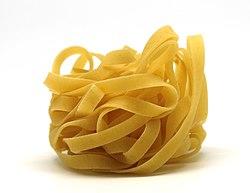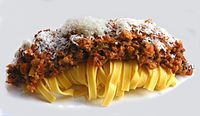 The distinctive shape of tagliatelle pasta | |
| Type | Pasta |
|---|---|
| Course | Primo |
| Place of origin | Italy |
| Region or state | Emilia-Romagna and Marche |
| Main ingredients | flour and egg |
| Variations | Pizzoccheri, tagliolini |
| Other information | Long and thin. Can be served with a creamy sauce and cheese. |
Tagliatelle (Italian pronunciation: [taʎʎaˈtɛlle] ; from the Italian tagliare, meaning "to cut") are a traditional type of pasta from the Emilia-Romagna and Marche regions of Italy. Individual pieces of tagliatelle are long, flat ribbons that are similar in shape to fettuccine and are typically about 6.5 to 10 mm (0.26 to 0.39 in) wide. Tagliatelle can be served with a variety of sauces, though the classic is a meat sauce or Bolognese sauce.
Tagliatelle are traditionally made with egg pasta. The traditional ratio is one egg to one hundred grams of flour.[1]
Origins
Legend has it that tagliatelle was created by a talented court chef, who was inspired by Lucrezia d'Este's hairdo on the occasion of her marriage to Annibale II Bentivoglio, in 1487. In reality, this was a joke invented by humorist Augusto Majani in 1931.
The recipe was called tagliolini di pasta e sugo, alla maniera di Zafiran (tagliolini of pasta and sauce in the manner of Zafiran) and it was served on silver plates.[2] Over the years, tagliatelle has become considered a more common food.
A glass case in the Bologna Chamber of Commerce holds a solid gold replica of a piece of tagliatelle, demonstrating the correct dimensions of 1 millimetre by 6 millimetres.[3]
Dishes
The texture is porous and rough, making it ideal for thick sauces, generally made with beef, veal, or pork (such as bolognese sauce), and occasionally with rabbit, as well as several other less rich (and more vegetarian) options, such as briciole e noci (with breadcrumbs and nuts), uovo e formaggio (with eggs and cheese—a less rich carbonara), or simply pomodoro e basilico (with tomatoes and basil).
See also
- Tagliolini
- Bavette
- Passatelli
- Pappardelle
- Fettuccine
References
- ^ "An Emilian Secret La Sfoglia". www.albertotriglia.it. Retrieved 26 January 2021.
- ^ Minarelli, Maria Luisa (1993). A tavola con la storia. Sansoni. ISBN 978-88-383-1501-5.
- ^ The Classic Italian Cookbook, 1973 by Marcella Hazan


